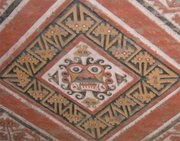Moche
|
|
Moche_pottery01.jpg
(Image © PROMPERU, used with permission)
The Moche civilization (aka the Mochica culture, Early Chimu, Pre-Chimu, Proto-Chimu, etc.) flourished in Northern Peru from about 200 CE to 700 CE. Today it is understood that they were not politically the same people as the Chimú, and some believe this was not even an empire but rather a group of communities that shared a common iconography and technology. Years as expansive as 300 BCE to 1000 CE are sometimes described as the era of the Moche. They are noted for the elaborate painted ceramics and pottery, gold work and irrigation systems. Moche history is broadly categorized into five periods based on the increasing complexity of pottery decoration. Many Moche ceramic pieces, including their highly detailed erotic pottery, can be found at the Museo de la Nacion and the Museo Larco Herrera, both in Lima.
The Moche lived principally in the valleys of three rivers: Chicama, Moche, and Viru. Major Moche cities include Sipan and Huancaco. There are several Moche ruins not far from the city of Trujillo, Peru. Huaca del Sol, a pyramidal structure on the Rio Moche, had been the largest pre-Columbian structure in Peru but was largely destroyed when Europeans mined its graves for gold. Fortunately the nearby Huaca de la Luna seems to have been more important to the Moche and remained largely intact. It contains many colorful murals with complex iconography and is being excavated as of 2004.
| Contents |
Pottery
Moche pottery is some of the most varied in the world. They used molds in order to mass produce huge quantities of it. But despite this, they had a large variation in shape and theme. Virtually all vegetables and important activities are documented in their pottery, including war, sex, metal work and weaving. They would apply figures on onto pottery before it dried, which is seldom done today because of the risk of explosion in the kiln if air gets into the joints.
They also seemed to be obsessed with individuality. Every one of the 100,000,000 bricks in the Huaca del Sol had a maker's mark. Important persons would have vases made to resemble their heads. The portrait vases also show the personality of the subject: some are shown laughing, others in deep thought, others angry, etc. Some people believe the Moche had contact with the Chinese and with Southern Africa because there are vases showing obviously mongoloid and negroid features. But no Chinese or African made artifacts of the period have been found in South America or vice-versa.
The coloration of Moche pottery is not very varied, white and red are used almost exclusively, with a yellowish cream color and black in only a few pieces. Their adobe buildings have mostly been destroyed by looters and the elements over the last 1300 years, but the two huacas that remain show that the coloring of their murals was much more varied, with every color of the rainbow represented. Not much is known about their clothing since it has all disintegrated; the Moche lived the North of Peru, which gets flooded in El Niño years.
Religion
Moche worship featured a figure called the decapitator, sometimes depicted with octopus-like arms. When the body is included it is always shown with one arm holding a knife and another holding a head by its hair. It is thought to figure in the ritual human sacrifice of foreign soldiers.
Demise
There are several theories as to what caused the demise of the Moche civilization. Studies of ice cores drilled from glaciers in the Andes reveal climatic catastophe between AD 550 to 600 when it is thought that coastal ares were hit by 30 years of floods and rain (Mega El Niño), which were then followed by 30 or more years of drought. Recent evidence uncovered by American Archeologist Tom Dillehay has shown that Moche civilization survived beyond AD 650 and later settlements are characterised by fortifications and defensive works. Finding no evidence of foreign invasion, this suggests that a period of unrest followed the climatic changes and Moche civilization tore itself apart. 1 (http://news.bbc.co.uk/1/hi/sci/tech/4311153.stm)
Other
The Moche was an Early Intermediate culture that co-existed with the Ica-Nazca culture. They were preceded by the Chavín horizon and succeeded by the Huari and Chimú. They are thought to have had some limited contact with the Ica-Nazca culture because they mined Guano for fertilizer in Ica-Nazca territory. Moche pottery has been found near Ica, but no Ica-Nasca pottery has been found in Moche territory.
Note: Mochica was the language spoken in the area when the Conquistadors arrived, but there is no indication that this was the language spoken by the Moche, so scientists still call them the Moche after the location of the primary archaeological site. There is some evidence they were the same people as the later culture known as Chimú.
External links
- The Lord of Sipan, "King Tutankhamen of the Americas" (http://agutie.homestead.com/files/Sipan.htm) by Antonio Gutierrez from "Geometry Step by Step from the Land of the Incas"
- Grim rites of the Moche (http://www.archaeology.org/0203/abstracts/moche.html)
de:Mochica es:Cultura Mochica fr:Moche ja:モチェ文化 pl:Kultura Mochica fi:Moche

